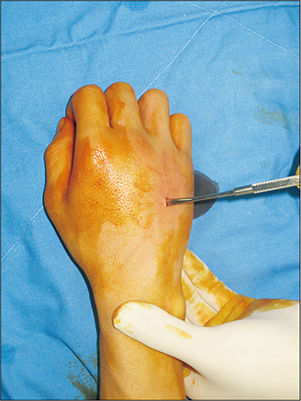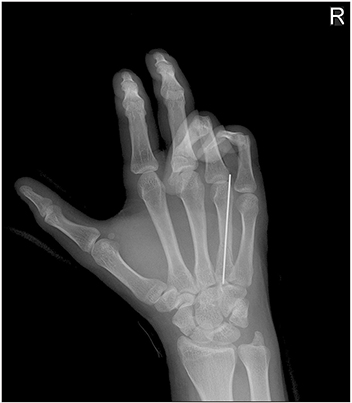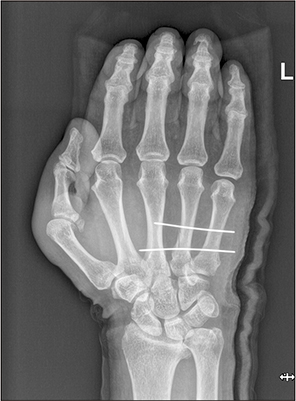Arch Hand Microsurg.
2019 Dec;24(4):321-329. 10.12790/ahm.2019.24.4.321.
Mini-Open Reduction of Isolated Metacarpal Bone Fracture
- Affiliations
-
- 1Department of Plastic and Reconstructive Surgery, Eunpyeong St. Mary's Hospital, College of Medicine, The Catholic University of Korea, Seoul, Korea.
- 2Department of Plastic and Reconstructive Surgery, St. Vincent's Hospital, College of Medicine, The Catholic University of Korea, Suwon, Korea. sharpshim@catholic.ac.kr
- KMID: 2464467
- DOI: http://doi.org/10.12790/ahm.2019.24.4.321
Abstract
- PURPOSE
Metacarpal bone fracture is a commonly encountered. The authors applied a minimally invasive open reduction technique that comprises only a stab incision to treat metacarpal bone fractures, thereby minimizing complications that accompany traditional open reduction methods while retaining the advantages of closed reduction techniques.
METHODS
A 5-year retrospective study was carried out of all patients who underwent surgical treatment performed by two separate hand surgeons. Total 37 patients were operated. Fourteen patients of conventional open reduction group and 23 patients of minimal invasive group were included in the study.
RESULTS
Mini-open reduction group had shorter operative time, comparable radiological reduction result, lower subjective pain, comparable mean active range of motion of the metacarpophalangeal joint, similar complication rate and superior outcome scar quality than conventional open reduction group.
CONCLUSION
Mini-open reduction method may be an alternative to conventional open reduction in treating metacarpal fractures.
MeSH Terms
Figure
Reference
-
1. Chung KC, Spilson SV. The frequency and epidemiology of hand and forearm fractures in the United States. J Hand Surg Am. 2001; 26:908–915.
Article2. Feehan LM, Sheps SB. Incidence and demographics of hand fractures in British Columbia, Canada: a populationbased study. J Hand Surg Am. 2006; 31:1068–1074.
Article3. Ben-Amotz O, Sammer DM. Practical management of metacarpal fractures. Plast Reconstr Surg. 2015; 136:370e–379e.
Article4. Henry MH. Fractures of the proximal phalanx and metacarpals in the hand: preferred methods of stabilization. J Am Acad Orthop Surg. 2008; 16:586–595.
Article5. Diaz-Garcia R, Waljee JF. Current management of metacarpal fractures. Hand Clin. 2013; 29:507–518.
Article6. Freeland AE, Lindley SG. Malunions of the finger metacarpals and phalanges. Hand Clin. 2006; 22:341–355.
Article7. Low CK, Wong HC, Low YP, Wong HP. A cadaver study of the effects of dorsal angulation and shortening of the metacarpal shaft on the extension and flexion force ratios of the index and little fingers. J Hand Surg Br. 1995; 20:609–613.
Article8. Friedrich JB, Vedder NB. An evidence-based approach to metacarpal fractures. Plast Reconstr Surg. 2010; 126:2205–2209.
Article9. Bloom JM, Hammert WC. Evidence-based medicine: metacarpal fractures. Plast Reconstr Surg. 2014; 133:1252–1260.10. Ozer K, Gillani S, Williams A, Peterson SL, Morgan S. Comparison of intramedullary nailing versus plate-screw fixation of extra-articular metacarpal fractures. J Hand Surg Am. 2008; 33:1724–1731.
Article11. Mumtaz MU, Farooq MA, Rasool AA, Kawoosa AA, Badoo AR, Dhar SA. Unstable metacarpal and phalangeal fractures: treatment by internal fixation using AO minifragment plates and screws. Ulus Travma Acil Cerrahi Derg. 2010; 16:334–338.12. Greeven AP, Bezstarosti S, Krijnen P, Schipper IB. Open reduction and internal fixation versus percutaneous transverse Kirschner wire fixation for single, closed second to fifth metacarpal shaft fractures: a systematic review. Eur J Trauma Emerg Surg. 2016; 42:169–175.
Article13. Facca S, Ramdhian R, Pelissier A, Diaconu M, Liverneaux P. Fifth metacarpal neck fracture fixation: Locking plate versus K-wire? Orthop Traumatol Surg Res. 2010; 96:506–512.
Article14. Dabezies EJ, Schutte JP. Fixation of metacarpal and phalangeal fractures with miniature plates and screws. J Hand Surg Am. 1986; 11:283–288.
Article15. Bosscha K, Snellen JP. Internal fixation of metacarpal and phalangeal fractures with AO minifragment screws and plates: a prospective study. Injury. 1993; 24:166–168.
Article16. Page SM, Stern PJ. Complications and range of motion following plate fixation of metacarpal and phalangeal fractures. J Hand Surg Am. 1998; 23:827–832.
Article
- Full Text Links
- Actions
-
Cited
- CITED
-
- Close
- Share
- Similar articles
-
- Operative Treatment of the Fracture of the Fourth and Fifth Metacarpal Bone Base
- Metacarpal Shaft Fracture Treated by Closed Reduction and Percutaneous Intramedullary K-wire Fixationv
- Operative Treatment of Metacarpal Shaft Fracture>: Comparision of Low-Profile Miniplating System and Kirschner Wire Fixation
- Fractures at the Base of the Fifth Metacarpal
- Avulsion Fracture of the Second Metacarpal Base by the Extensor Carpi Radialis Longus: A Case Report






